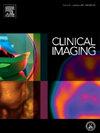基于超声的机器学习模型预测乳腺癌对新辅助化疗的反应:一项荟萃分析
IF 1.5
4区 医学
Q3 RADIOLOGY, NUCLEAR MEDICINE & MEDICAL IMAGING
引用次数: 0
摘要
背景和目的乳腺癌仍然是全球女性中最常见的癌症,新辅助化疗(NAC)是一项关键的术前干预措施。基于超声的放射组学和机器学习(ML)模型为NAC反应的早期预测提供了潜力,有助于个性化治疗策略。本研究系统回顾了基于超声的ML模型预测乳腺癌患者NAC反应的有效性。方法根据PRISMA-DTA指南,检索PubMed、Scopus、Web of Science和Embase,检索截止到2023年8月30日的文献,进行系统综述和meta分析。包括开发基于超声的放射组学或深度学习(DL)模型来预测NAC反应的研究。对完全响应和部分响应模型分别进行了分析。结果共纳入22项研究。对于预测完全缓解的模型,内部验证的总灵敏度、特异性和AUC分别为85.1% (95% CI: 79.2 - 89.6%)、85.8% (95% CI: 76.7 - 91.8%)和86% (95% CI: 82% - 94%),外部验证的总灵敏度、特异性和AUC分别为82.9% (95% CI: 76.2% - 88.1%)、89.4% (95% CI: 84.7% - 92.9%)和93% (95% CI: 82% - 94%)。对于部分反应,分析只能进行内部验证,合并敏感性为87.5% (95% CI: 85.1 - 89.6%),合并特异性为82.3% (95% CI: 75.6 - 87.5%),合并AUC为88% (95% CI: 85% - 92%)。结论基于超声的ML模型在预测乳腺癌NAC反应方面具有很强的潜力,δ放射组学可以提高预测的准确性。需要进一步的研究来开发临床推广的模型。本文章由计算机程序翻译,如有差异,请以英文原文为准。
Ultrasound-based machine learning models for predicting response to neoadjuvant chemotherapy in breast cancer: A meta-analysis
Background and aims
Breast cancer remains the most common cancer among women globally, with neoadjuvant chemotherapy (NAC) serving as a critical pre-surgical intervention. Ultrasound-based radiomics and machine learning (ML) models offer potential for early prediction of NAC response, aiding personalized treatment strategies. This study systematically reviews the efficacy of ultrasound-based ML models in predicting NAC response in breast cancer patients.
Methods
We conducted a systematic review and meta-analysis following PRISMA-DTA guidelines, searching PubMed, Scopus, Web of Science, and Embase up to August 30, 2023. Studies developing ultrasound-based radiomics or deep learning (DL) models to predict NAC response were include. Models for complete and partial response were analyzed separately.
Results
Twenty-two studies were included. For models predicting complete response, pooled sensitivity, specificity, and AUC were 85.1 % (95 % CI: 79.2–89.6 %), 85.8 % (95 % CI: 76.7–91.8 %), and 86 % (95 % CI: 82 %–94 %), respectively for internal validation and 82.9 % (95 % CI: 76.2 % - 88.1 %), 89.4 % (95 % CI: 84.7 %–92.9 %), and 93 % (95 % CI: 82 %–94 %), respectively for external validation. For partial response, analysis could only be performed on internal validation and the pooled sensitivity was 87.5 % (95 % CI: 85.1–89.6 %) with pooled specificity of 82.3 % (95 % CI: 75.6–87.5 %), and pooled AUC of 88 % (95 % CI: 85 %–92 %).
Conclusion
Ultrasound-based ML models show strong potential for predicting NAC response in breast cancer, with delta radiomics enhancing predictive accuracy. Further research is needed to develop clinically generalizable models.
求助全文
通过发布文献求助,成功后即可免费获取论文全文。
去求助
来源期刊

Clinical Imaging
医学-核医学
CiteScore
4.60
自引率
0.00%
发文量
265
审稿时长
35 days
期刊介绍:
The mission of Clinical Imaging is to publish, in a timely manner, the very best radiology research from the United States and around the world with special attention to the impact of medical imaging on patient care. The journal''s publications cover all imaging modalities, radiology issues related to patients, policy and practice improvements, and clinically-oriented imaging physics and informatics. The journal is a valuable resource for practicing radiologists, radiologists-in-training and other clinicians with an interest in imaging. Papers are carefully peer-reviewed and selected by our experienced subject editors who are leading experts spanning the range of imaging sub-specialties, which include:
-Body Imaging-
Breast Imaging-
Cardiothoracic Imaging-
Imaging Physics and Informatics-
Molecular Imaging and Nuclear Medicine-
Musculoskeletal and Emergency Imaging-
Neuroradiology-
Practice, Policy & Education-
Pediatric Imaging-
Vascular and Interventional Radiology
 求助内容:
求助内容: 应助结果提醒方式:
应助结果提醒方式:


